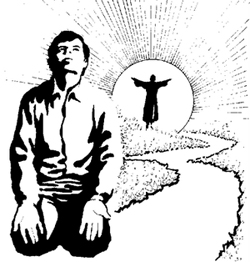
At that time, the priest was also a scripture professor of note at the Seminary, a columnist for the Long Island Catholic weekly newspaper, and was serving weekend masses at a parish in Centerport. He had just completed his doctoral thesis about the proportionally large number of sexually conflicted men who became priests. Subsequent to the publication of his thesis, the priest was summarily removed from his teaching position at the Seminary and was reassigned to a parish.
In context with today's perspective on priestly sexual dysfunction, the priest probably would have been viewed as a whistle-blower, who had been punished by a diocese with its own very serious personnel problems. He resigned the priesthood a short time after his reassignment, he got married, raised kids, and became a practicing psychologist in Suffolk County on Long Island.
Although my thesis on celibacy is imperfect in many ways and is certainly somewhat dated--having been written years prior to the more recent furor over the abuse of children by Catholic priests-- it may nonetheless provide some insight into the pathology within the Church infrastructure and a foreshadowing of what was to come.
Some individuals may question the direct relevance of clerical abstinence to the issue of sexual abuse of children by priests. However, at the time I wrote the paper and still today, I placed a great deal of faith in statistics which suggest that the celibacy requirement dramatically limits the potential diversity of the priesthood and seems to attract an overwhelming number of immature men who seem somewhat confused about their sexuality. While the number of priests being accused of sexual abuse is a relatively small percentage, there does seem to be a preponderance of closeted homosexuality, secrecy, cover-ups, and human resource mismanagement in far too many parishes and dioceses across the U.S. Such conditions create an atmosphere that permeates the true essence of priestly function and renders many clerics incapable of following Christ's edicts grounded with honesty and integrity.
An aging priesthood and the influx of foreign priests--who barely speak English let alone grasp the culture of the people they are supposed to be inspiring--are causing further estrangement between the church and American parishioners. I am still convinced that the Catholic Church in the U.S. can heal many of it present wounds by welcoming back as deacons previously excommunicated priests (as well as those having been laicized) who gave up the priesthood to marry and to raise children. The concept of allowing women to become Catholic priests is, of course, another if not more direct solution; but one that is much too much to expect from the incumbent papacy and its selective embrace of John Paul II's Ordinatio Sacerdotalis. Meanwhile, the celibacy issue may continue to drive more nails into the coffin of a stolid and sinful church infrastructure that Jesus never envisioned nor would he ever have condoned.
http://www.arthurstreet.com/celibacy1993.html